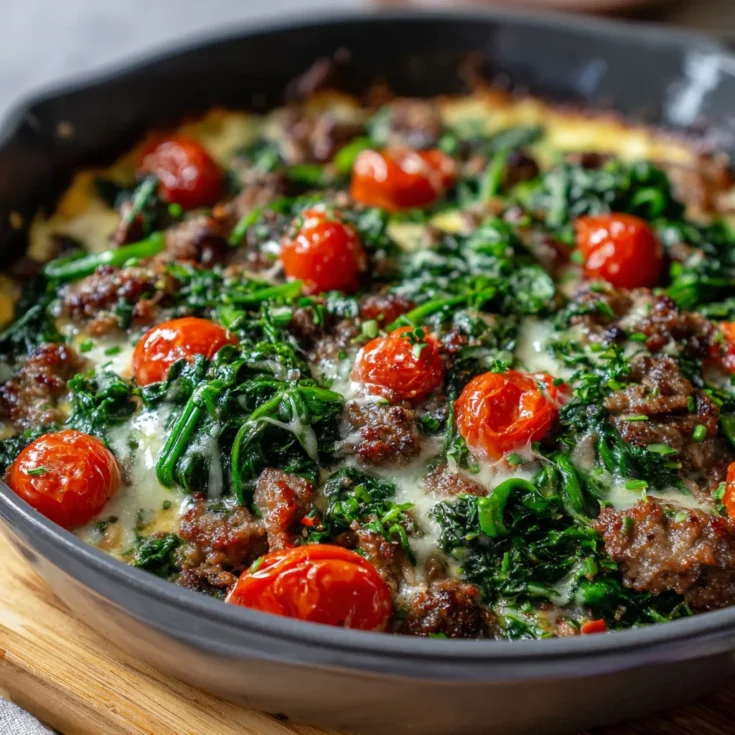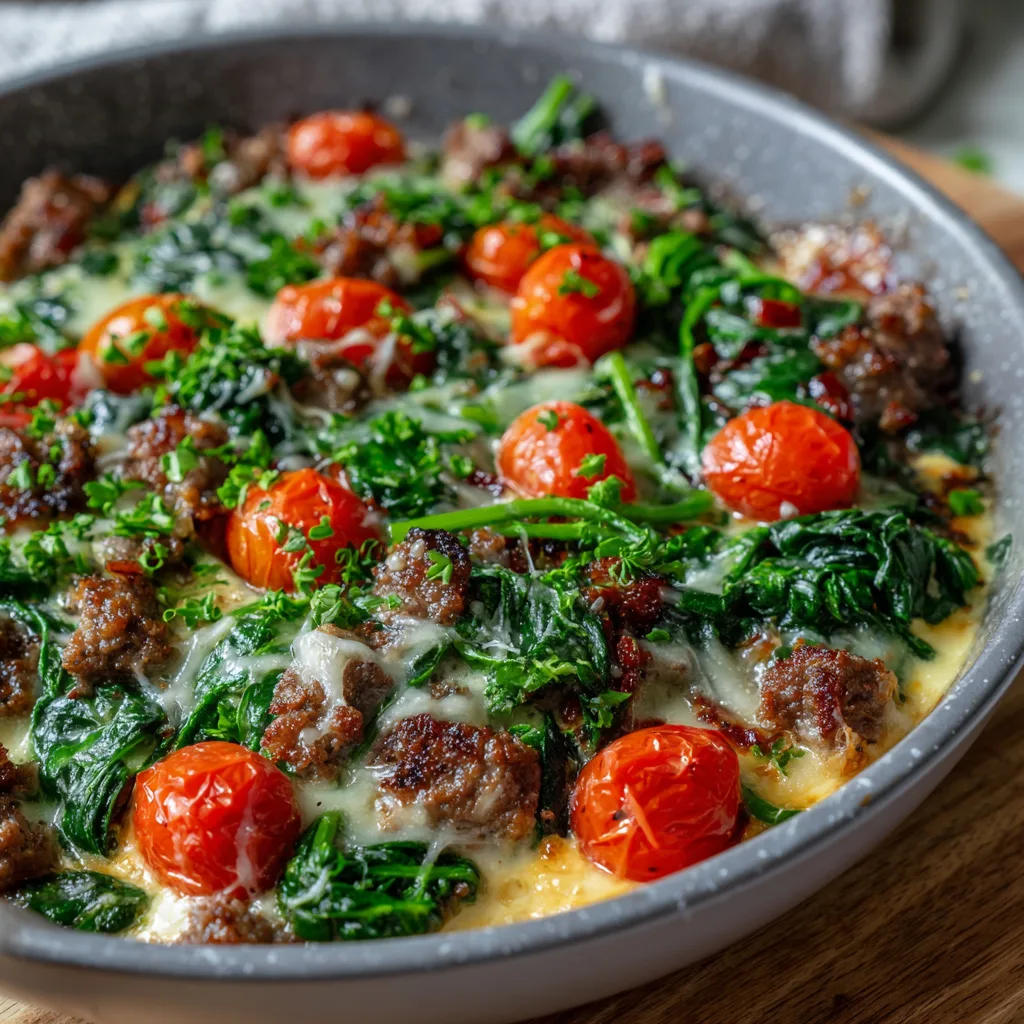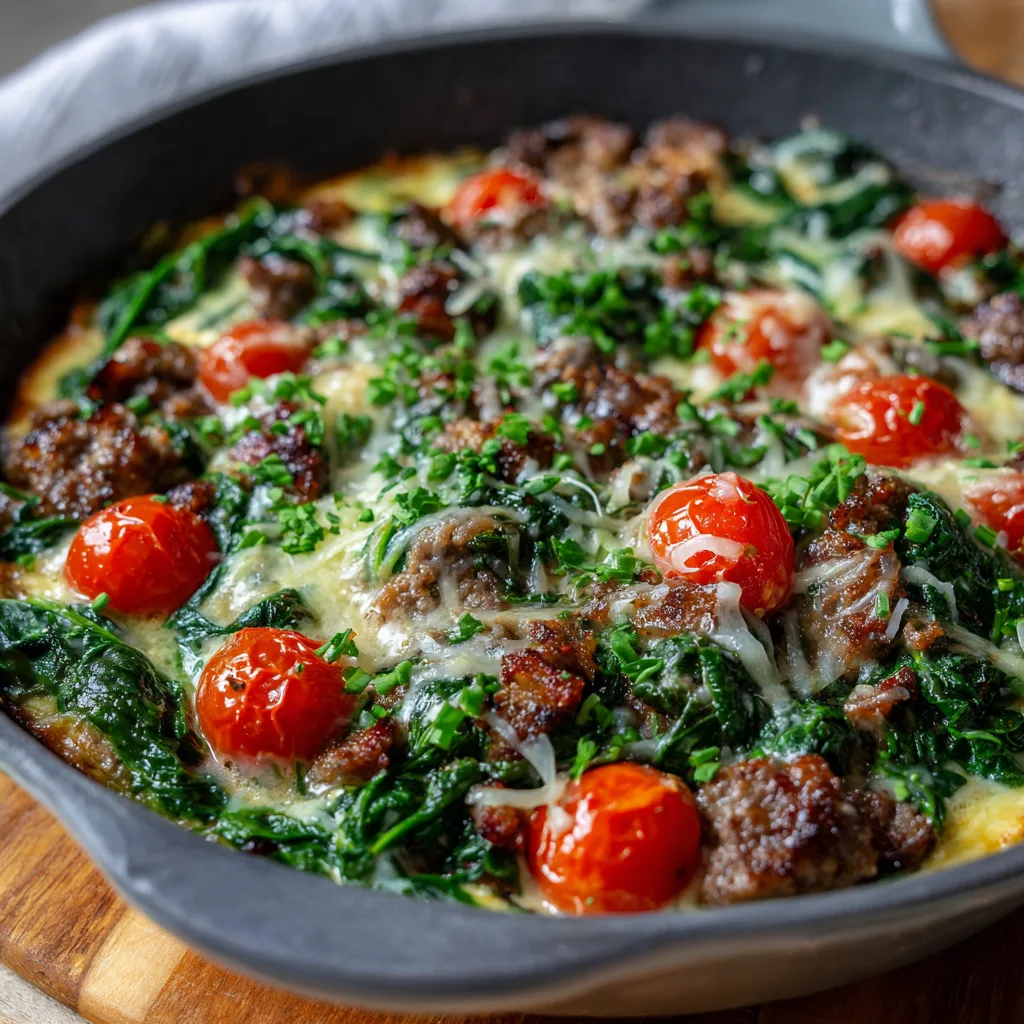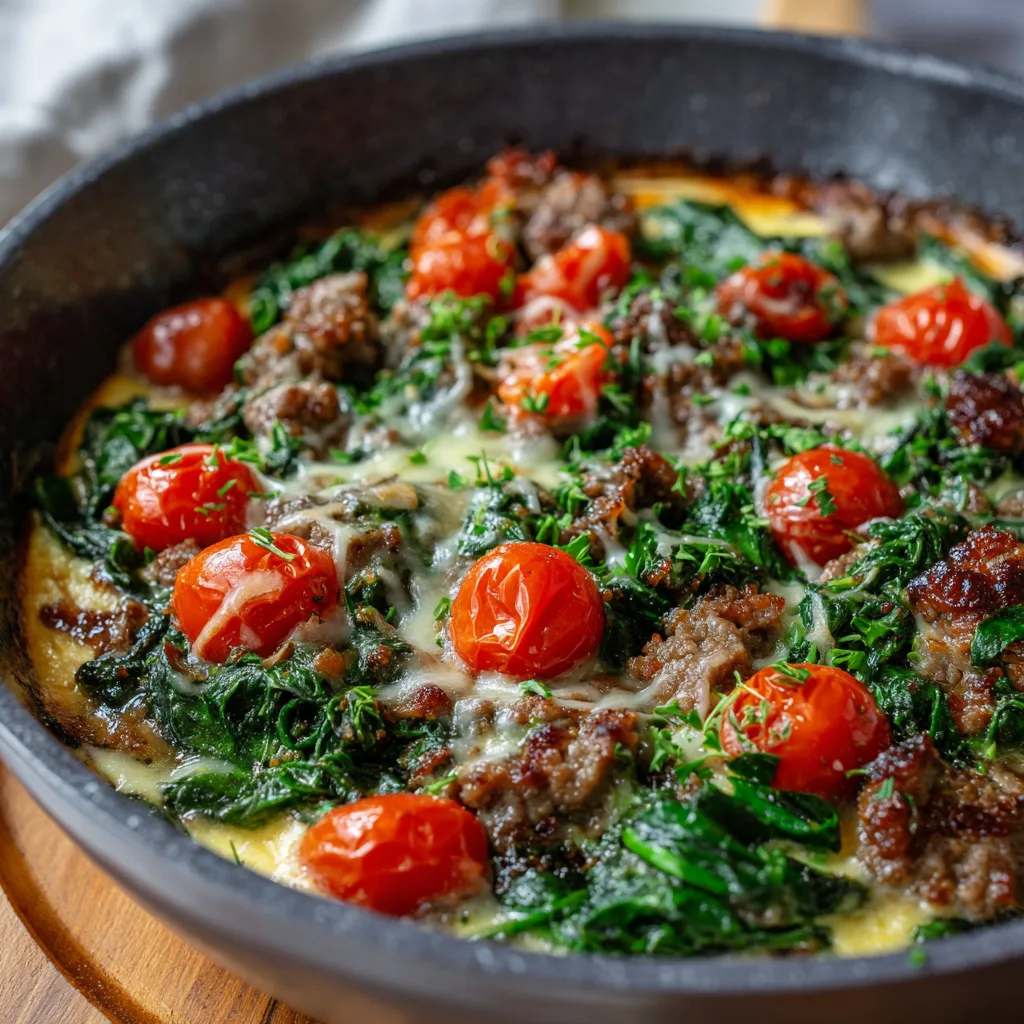What Is a Low-Carb Spinach Skillet?
A low-carb spinach skillet is a quick, nutritious meal cooked entirely in one pan, focusing on spinach and other low-carbohydrate ingredients. This dish fits perfectly into low-carb diets, where limiting carbohydrate intake helps promote weight management and improve blood sugar control. Spinach serves as the star ingredient, packed with vitamins and minerals that fuel the body while keeping carbs low.
Incorporating spinach brings numerous benefits. This leafy green is rich in antioxidants, fiber, and essential nutrients like iron and vitamin K. It supports heart health, aids digestion, and enhances overall wellness. When paired with proteins and healthy fats, spinach transforms into a satisfying meal that aligns with low-carb lifestyle goals. Whether you’re new to low-carb eating or seeking fresh dinner ideas, a spinach skillet offers a flavorful and healthful option.
Why Choose a Skillet for Cooking?
Using a skillet for meals simplifies dinner preparation and cleanup. One-pan meals save time by combining ingredients in a single dish, allowing flavors to meld seamlessly. This method also preserves nutrients better than boiling or steaming because it uses less water and shorter cooking times.
Skillet cooking intensifies flavors as ingredients sauté and simmer together. The direct heat creates a delicious caramelization on proteins and vegetables, enriching every bite. Additionally, a skillet offers versatility, accommodating various ingredients and cooking styles. From quick weeknight dinners to hearty meal prep, skillet dishes deliver convenience without sacrificing taste or nutrition. Choosing a skillet for your low-carb spinach meal ensures an easy, wholesome, and tasty dinner every time.
Nutritional Profile of Spinach
Spinach stands out as a nutritional powerhouse. This leafy green delivers an impressive array of vitamins, including A, C, and K, essential for vision, immunity, and blood clotting. It also provides vital minerals like iron, magnesium, and calcium, which support energy production, muscle function, and bone strength. Beyond vitamins and minerals, spinach boasts potent antioxidants such as lutein and zeaxanthin. These compounds protect cells from damage caused by harmful free radicals, promoting overall health and reducing the risk of chronic diseases.
Role of Spinach in Low-Carb Eating Plans
Spinach perfectly fits into low-carb diets because it contains very few carbohydrates. A cup of raw spinach has less than one gram of net carbs, making it an excellent choice for keeping carbohydrate intake in check. Additionally, spinach is rich in fiber and water, which help promote feelings of fullness and support healthy digestion. Fiber slows down digestion, stabilizing blood sugar levels and reducing cravings. The high water content also aids hydration and helps maintain a healthy metabolism. Together, these features make spinach a valuable ingredient for those managing carbohydrate intake while still wanting satisfying meals.
Health Benefits of Spinach for Low-Carb Dieters
Eating spinach regularly supports heart health by helping lower blood pressure and reducing inflammation. Its rich potassium content balances sodium levels, promoting healthy circulation. Spinach’s anti-inflammatory properties stem from its unique blend of antioxidants, which help calm chronic inflammation linked to heart disease and other conditions. Moreover, spinach contributes to strong bones thanks to its high vitamin K and calcium levels. Vitamin K plays a crucial role in bone mineralization, enhancing bone density and reducing fracture risk. These health benefits make spinach an essential part of any low-carb diet focused on long-term wellness.
Essential Ingredients for a Low-Carb Spinach Skillet
The foundation of any low-carb spinach skillet starts with fresh, vibrant spinach. Using fresh spinach ensures a bright flavor and maximum nutrient retention. Its tender leaves wilt perfectly in the skillet, creating a silky base for the dish. Pair spinach with quality protein sources like chicken, sausage, shrimp, or tofu. These proteins provide essential amino acids that keep you full and support muscle health. Chicken offers lean, mild-flavored protein, while sausage adds bold, savory notes. Shrimp brings a light, slightly sweet taste, and tofu suits plant-based diets with its versatility and texture.
Healthy fats elevate the skillet by adding richness and boosting nutrient absorption. Olive oil is a classic choice, lending a fruity aroma and heart-healthy monounsaturated fats. Avocado adds creaminess and beneficial fats that support brain health. For extra texture and crunch, sprinkle nuts such as walnuts or pine nuts over the finished dish. These ingredients combine to form a balanced, nutrient-dense meal that fits perfectly into low-carb lifestyles.
Flavor Enhancers That Bring the Skillet to Life
Garlic and onions provide the aromatic foundation for the skillet’s flavor profile. Their sharp, savory notes balance the earthiness of spinach. Fresh herbs like basil, thyme, or parsley brighten the dish with refreshing hints. To add warmth and depth, incorporate spices such as paprika, cumin, or turmeric. Paprika lends a mild smoky sweetness, cumin adds earthiness, and turmeric contributes vibrant color along with anti-inflammatory benefits. These flavor enhancers turn a simple skillet into a mouthwatering meal.
Optional Add-Ins for Variety and Extra Taste
Cheese is a popular addition that introduces creaminess and tang. Feta adds a salty, crumbly texture, parmesan melts into a nutty, savory layer, and cream cheese enriches the sauce with smooth decadence. For more vegetables, consider mushrooms and bell peppers. Mushrooms bring umami depth and a meaty texture, while bell peppers add a sweet crunch and bright color. These optional ingredients allow customization while keeping the dish low in carbs and full of flavor.
Preparation: Getting Your Ingredients Ready
Start by thoroughly washing fresh spinach under cold running water. Removing any dirt or grit ensures a clean, fresh taste. After washing, chop the spinach roughly or leave the leaves whole depending on your preference. Preparing spinach in this way helps it cook evenly and wilt quickly in the skillet.
Next, prep your protein and vegetables. If using chicken or sausage, slice into bite-sized pieces for quick cooking. For shrimp, peel and devein before cooking. Tofu should be pressed to remove excess moisture, then cut into cubes. Chop any additional vegetables like bell peppers or mushrooms into uniform pieces to promote even cooking. Having all ingredients ready before turning on the heat speeds up the cooking process and helps maintain freshness.
Cooking Process: Building Layers of Flavor
Heat olive oil in a large skillet over medium heat. Begin by sautéing aromatics such as minced garlic and diced onions until they become fragrant and translucent. This step releases their natural sweetness and forms a flavorful base for the dish.
Add your protein next, cooking until it develops a golden-brown crust. This caramelization locks in juices and boosts flavor. Stir occasionally to ensure the protein cooks evenly on all sides.
Once the protein is nearly cooked, add your prepared vegetables and fresh spinach. Toss everything together, allowing the spinach to wilt gently. This process usually takes just a few minutes as spinach cooks quickly and retains its nutrients when cooked briefly.
Finally, incorporate sauces or broths to enhance moisture and taste. Options include heavy cream, chicken broth, or a splash of lemon juice. Stir well to combine, letting the mixture simmer so the flavors meld perfectly.
Final Touches: Perfecting Your Skillet Dish
Adjust the seasoning by tasting and adding salt, pepper, or spices as needed. If desired, add cheese such as parmesan or cream cheese to enrich the skillet with creamy texture. Stir the cheese into the hot skillet until melted and well incorporated. This adds depth and a satisfying finish to your meal.
Cooking Tips: Mastering the Skillet Technique
Maintain medium heat throughout the cooking process to avoid burning ingredients or undercooking proteins. If the skillet becomes too hot, reduce the flame to preserve delicate flavors.
To prevent overcooking spinach, add it last and cook just until it wilts. Overcooked spinach loses its vibrant green color and becomes mushy, reducing appeal and nutritional value. Keep an eye on texture and remove the skillet from heat promptly when the spinach softens.
Following these steps will yield a delicious, well-balanced low-carb spinach skillet perfect for any dinner occasion.
Protein Variations for Your Low-Carb Spinach Skillet
Choosing the right protein can transform your skillet meal. Chicken breast offers lean meat with mild flavor, perfect for those who prefer a lighter dish. Alternatively, chicken thighs provide richer taste and juicier texture thanks to higher fat content. Ground turkey or beef also work well, adding heartiness and a different flavor profile. For plant-based eaters, tofu and tempeh stand out as excellent protein options. Both absorb spices and sauces beautifully, ensuring your skillet stays flavorful and satisfying while remaining low in carbs.
Flavor Profiles to Customize Your Skillet Dinner
You can easily switch up flavors to keep the dish exciting. For a Mediterranean twist, add olives and sun-dried tomatoes. These ingredients bring briny, sweet notes that complement the earthiness of spinach. If you prefer Asian-inspired flavors, incorporate soy sauce and sesame oil. These add umami depth and a subtle nuttiness. To add heat and spice, sprinkle chili flakes or include sliced jalapeños. This fiery touch balances the creamy spinach and protein, creating a bold, vibrant dish.
Dietary Considerations for Every Need
Adapting the recipe to fit dietary restrictions is simple. For dairy-free meals, omit cheese and use coconut cream or almond milk as a creamy substitute. Those following gluten-free diets can enjoy this skillet naturally, as it contains no gluten ingredients. Just double-check seasoning blends and sauces to ensure they are gluten-free. For nut allergies, avoid adding nuts as toppings and skip avocado if sensitive. Instead, use seeds like pumpkin or sunflower seeds for crunch. These swaps allow everyone to enjoy a wholesome, low-carb spinach skillet without compromising taste or nutrition.
Frequently Asked Questions
Can I use frozen spinach instead of fresh?
Yes, but make sure to thaw it fully and drain excess water before cooking to avoid sogginess.
How do I store leftovers?
Place leftovers in an airtight container and refrigerate for up to 3 days to maintain freshness.
Can I prepare this dish in advance?
Absolutely. Prepare up to adding the cream, then refrigerate. Finish cooking when ready to serve.
What can I serve with this skillet?
Pair it with a fresh side salad, roasted low-carb vegetables, or a slice of low-carb bread.
Can I make this vegetarian?
Yes, replace chicken with tofu or tempeh and use vegetable broth instead of chicken broth for flavor.
For Dinner Low Carb Spinach Skillet – Quick & Healthy Meal

This rich and creamy chicken skillet combines garlic and fresh spinach for a satisfying low-carb dinner. It’s simple to prepare and packed with flavor.
Ingredients
- 4 boneless, skinless chicken breasts
- 2 tablespoons olive oil
- 3 cloves garlic, minced
- 4 cups fresh spinach
- 1 cup heavy cream
- ½ cup grated parmesan cheese
- Salt and pepper to taste
Instructions
Notes




